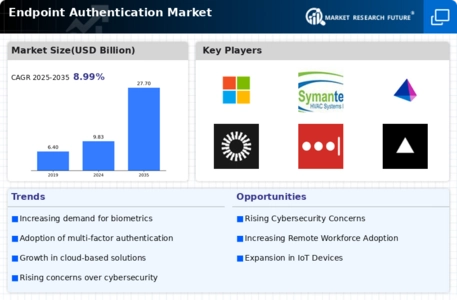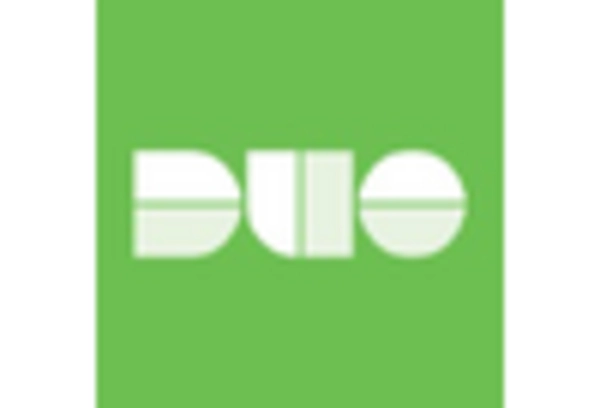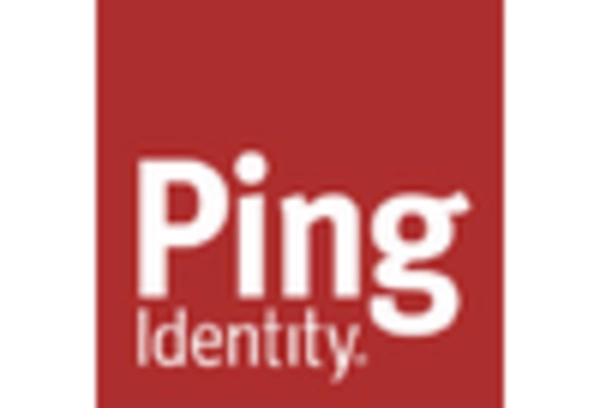Adoption of Remote Work Policies
The Endpoint Authentication Market is witnessing a transformation driven by the widespread adoption of remote work policies. As organizations embrace flexible work arrangements, the need for secure access to corporate resources from various locations has intensified. This shift has led to an increased reliance on endpoint authentication solutions to ensure that only authorized users can access sensitive data. In 2025, it is anticipated that the remote workforce will comprise over 30 percent of The Endpoint Authentication, further propelling the demand for effective authentication mechanisms. Consequently, the Endpoint Authentication Market is poised for growth as businesses seek to secure their remote access points.
Increasing Cybersecurity Threats
The Endpoint Authentication Market is experiencing a surge in demand due to the escalating frequency and sophistication of cyber threats. Organizations are increasingly recognizing the necessity of robust authentication mechanisms to safeguard sensitive data. In 2025, it is estimated that cybercrime will cost businesses over 10 trillion dollars annually, prompting a shift towards advanced endpoint authentication solutions. This trend indicates that companies are prioritizing security investments, particularly in authentication technologies, to mitigate risks associated with data breaches and identity theft. As a result, the Endpoint Authentication Market is likely to witness substantial growth as enterprises seek to enhance their security posture against evolving threats.
Growing Awareness of Data Privacy
The Endpoint Authentication Market is increasingly influenced by the growing awareness of data privacy among consumers and businesses alike. As individuals become more conscious of their personal information and its potential misuse, organizations are compelled to adopt stringent security measures to protect user data. This heightened awareness is driving the demand for endpoint authentication solutions that ensure secure access and data protection. In 2025, it is projected that consumer concerns regarding data privacy will lead to a 25 percent increase in investments in authentication technologies. Thus, the Endpoint Authentication Market is expected to thrive as organizations prioritize data privacy and security.
Regulatory Compliance Requirements
The Endpoint Authentication Market is significantly influenced by stringent regulatory frameworks that mandate enhanced security measures. Regulations such as the General Data Protection Regulation (GDPR) and the Health Insurance Portability and Accountability Act (HIPAA) necessitate organizations to implement robust authentication protocols to protect sensitive information. As compliance becomes increasingly critical, businesses are compelled to adopt advanced endpoint authentication solutions to avoid hefty fines and reputational damage. In 2025, the market is projected to grow as organizations invest in technologies that ensure compliance with these regulations, thereby driving the demand for innovative authentication methods within the Endpoint Authentication Market.
Technological Advancements in Authentication Methods
The Endpoint Authentication Market is being propelled by rapid technological advancements in authentication methods. Innovations such as multi-factor authentication (MFA), biometric recognition, and behavioral analytics are reshaping the landscape of endpoint security. These technologies not only enhance security but also improve user experience, making them attractive to organizations. In 2025, the market for biometric authentication alone is expected to reach 30 billion dollars, indicating a strong trend towards adopting cutting-edge solutions. As organizations strive to stay ahead of potential threats, the Endpoint Authentication Market is likely to expand as they invest in these advanced authentication technologies.


















Leave a Comment